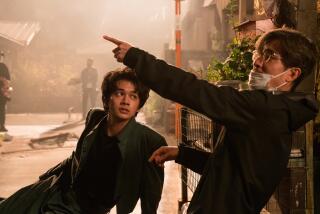Young men in love
- Share via
After capturing a deranged bomber, a pair of New York City police detectives share a passionate kiss. A group of teenage girls agree that “one of the seven strangest things” about their high school is that the handsome soccer star and his inseparable pal don’t have girlfriends. Two half brothers, the sons of a yakuza boss, compete for the affection of a former kendo champion.
Welcome to the curious world of yaoi: manga (graphic novels), doujinshi (amateur comics), animated films and prose depicting romances between beautiful young men -- created by women and aimed at female audiences. The phenomenon originated in Japan in the late ‘70s but is gradually catching on in the U.S.
For the record:
12:00 a.m. July 2, 2004 For The Record
Los Angeles Times Friday July 02, 2004 Home Edition Main News Part A Page 2 National Desk 1 inches; 60 words Type of Material: Correction
Animation -- A caption in the index of Wednesday’s Calendar section incorrectly identified an image from “Cardcaptor Sakura” as “a popular yaoi manga about young male lovers.” Yaoi manga are graphic novels that depict romance between young men. The image was actually taken from the animated version of “Sakura,” and the story is primarily about a female character’s magical adventures.
* The Anime Expo taking place this weekend in Anaheim will offer a panel on yaoi fandom -- and plenty of related merchandise; the annual Yaoi-Con will be held in San Francisco at the end of October.
* Translations of yaoi manga regularly appear at the top of the BookScan rankings of graphic novels, and the new imprint “Be Beautiful” (“Romantic graphic novels by women -- for women”) launches in August with two yaoi titles.
* EBay and the big Japanese auction sites Mandarake and Rinkya list hundreds of yaoi items.
“It’s definitely growing in the U.S. When we ask fans what type of titles they’re interested in having us bring over, yaoi titles are always at the top of the list,” says Jake Forbes, an editor at Los Angeles-based publisher and distributor Tokyopop. “We knew there’d be demand, but we didn’t realize how widespread it would be until we put out the mangas ‘Fake’ and ‘Gravitation.’ ‘Robotech’ got a lot of people into anime back in the ‘80s; these titles have made it into a huge underground phenomenon.”
“The term ‘yaoi’ comes from the phrase ‘YAma-nashi, Ochi-nashi, Imi-nashi’ -- no climax, no punch line, no meaning,” explains Frederik Schodt, the author of “Dreamland Japan: Writings on Modern Manga.” “It was originally applied to doujinshi by women artists who had a playful approach to storytelling. Many of their comics featured young males falling in love with each other.”
Gender-bending entertainments have been popular in Japan for centuries. In Kabuki, female characters are portrayed by onagata, male actors who specialize in feminine roles. The Takarazuka Revue mounts elaborate spectacles with young women playing all the parts, and the women who star in male roles boast huge fan clubs.
Some yaoi manga and animation stories only hint at an attraction between characters and some are blatant pornography. In “Cardcaptor Sakura,” a popular manga and animated program, Toya, the title character’s athletic older brother, gives up his magic powers to preserve the life of his companion, Yukito. But almost no physical contact occurs between them. Special agent Tsuzuki and his emerald-eyed partner, Hisoka, embrace only once in the anime “Descendants of Darkness,” but the gay subtext is palpable. By contrast, “My Sexual Harassment” depicts the rise of a young executive who prostitutes himself to his corporate superiors. The feeble plot is there just to provide a link to the animated sex scenes.
Most yaoi stories offer a vision of romance that emphasizes patience, gentleness and emotional commitment. The story lines include:
* Macho, bisexual New York City police detective Dee Laytner immediately falls for his new partner, half-Japanese Randy “Ryo” McLaine in Sanami Matoh’s manga “Fake.” For most of the seven volumes (and the animated feature), Dee gets only an occasional kiss from Ryo, who is unsure of his sexuality.
* Aspiring rock vocalist Shuichi Shendo meets novelist Eiri Yuki and is immediately smitten with him in “Gravitation” by Maki Murakami. The purity of Shuichi’s affection puzzles the antisocial writer: “I don’t get you. A lot of people have tried to claim me for themselves. Truth is, what they thought they wanted wasn’t really me.” Both characters consider themselves heterosexual, yet they initiate a lively physical relationship early in the manga and the animated series, which recently debuted here on DVD.
Dee and Ryo are portrayed as strong-willed, capable adults. In “Gravitation,” Eiri is an older, dominant figure; Shuichi is younger, physically smaller and more vulnerable. April Gutierrez, a spokeswoman for Yaoi-Con, notes, “Shuichi is definitely the high school girl analog. People who don’t like ‘Gravitation’ think he’s too much like a girl.”
Mike Kiley, an executive with Tokyopop, adds, “ ‘Gravitation’ appeals to a slightly younger crowd than ‘Fake,’ but a crowd that is really responding to the whole yaoi phenomenon.”
Why yaoi has become so popular is the subject of considerable debate. The beautiful, androgynous young men of yaoi fiction, with their long hair, long limbs and slender, hairless bodies contrast sharply with the stern, muscular, short-haired males in men’s manga, many of whom are sadistic or misogynistic by Western standards. Some cultural observers argue these stories allow Japanese women to escape the bonds of a society that restricts them.
Timothy Perper, co-author of the article “Sex, Love, and Women in Japanese Comics” in “The Comprehensive International Encyclopedia of Sexuality,” maintains that yaoi, “explores female views of masculinity and of the male body in ways that do not degrade or threaten the female viewer and which allow her to focus enthusiastically and openly on all the sexual-romantic things that men do.”
Gutierrez offers a more straightforward explanation: “Because there are no women, there’s no one for you to feel jealous about. You can just enjoy the story without projecting yourself into it or worrying about the annoying female characters who often pop up in anime and manga. Plus, your typical yaoi guy is going to be extraordinarily beautiful, so you can double your enjoyment adding a second guy.”
Tokyopop’s Kiley has an even simpler reason for yaoi’s popularity: “The teenage girls that I run into think these guys are hot. They’re comfortable with them because they’re not macho. In my opinion, yaoi isn’t really about guys getting together. It’s meant to portray relationships that are heterosexual at their foundation.”
*
Anime Expo
Where: The 13th Annual Anime Expo, Anaheim Convention Center, 800 W. Katella Ave., Anaheim
When: Main events, 10 a.m.-11 p.m. (or midnight) Friday to Sunday; 10 a.m.-3 p.m. Monday
Price: All four days, $50; one day only, $25; two days only, $40; Child: $20 (12 and younger)
Contact: www.anime-expo.org/index2004.html
More to Read
The biggest entertainment stories
Get our big stories about Hollywood, film, television, music, arts, culture and more right in your inbox as soon as they publish.
You may occasionally receive promotional content from the Los Angeles Times.










